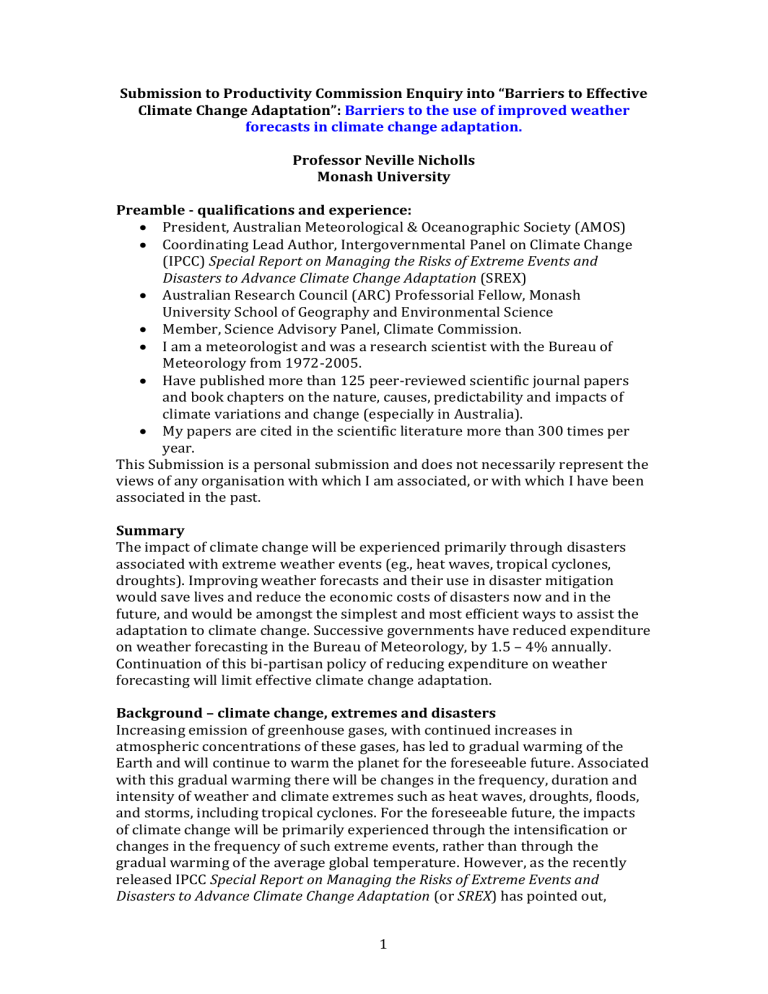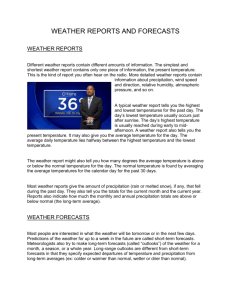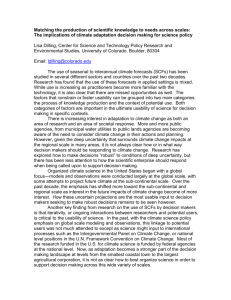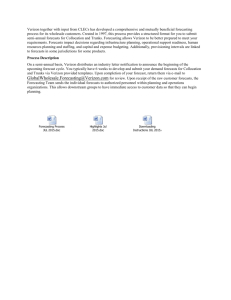Word - 41 Kb - Productivity Commission

Submission to Productivity Commission Enquiry into “Barriers to Effective
Climate Change Adaptation”: Barriers to the use of improved weather forecasts in climate change adaptation.
Professor Neville Nicholls
Monash University
Preamble - qualifications and experience:
President, Australian Meteorological & Oceanographic Society (AMOS)
Coordinating Lead Author, Intergovernmental Panel on Climate Change
(IPCC) Special Report on Managing the Risks of Extreme Events and
Disasters to Advance Climate Change Adaptation (SREX)
Australian Research Council (ARC) Professorial Fellow, Monash
University School of Geography and Environmental Science
Member, Science Advisory Panel, Climate Commission.
I am a meteorologist and was a research scientist with the Bureau of
Meteorology from 1972-2005.
Have published more than 125 peer-reviewed scientific journal papers and book chapters on the nature, causes, predictability and impacts of climate variations and change (especially in Australia).
My papers are cited in the scientific literature more than 300 times per year.
This Submission is a personal submission and does not necessarily represent the views of any organisation with which I am associated, or with which I have been associated in the past.
Summary
The impact of climate change will be experienced primarily through disasters associated with extreme weather events (eg., heat waves, tropical cyclones, droughts). Improving weather forecasts and their use in disaster mitigation would save lives and reduce the economic costs of disasters now and in the future, and would be amongst the simplest and most efficient ways to assist the adaptation to climate change. Successive governments have reduced expenditure on weather forecasting in the Bureau of Meteorology, by 1.5 – 4% annually.
Continuation of this bi-partisan policy of reducing expenditure on weather forecasting will limit effective climate change adaptation.
Background – climate change, extremes and disasters
Increasing emission of greenhouse gases, with continued increases in atmospheric concentrations of these gases, has led to gradual warming of the
Earth and will continue to warm the planet for the foreseeable future. Associated with this gradual warming there will be changes in the frequency, duration and intensity of weather and climate extremes such as heat waves, droughts, floods, and storms, including tropical cyclones. For the foreseeable future, the impacts of climate change will be primarily experienced through the intensification or changes in the frequency of such extreme events, rather than through the gradual warming of the average global temperature. However, as the recently released IPCC Special Report on Managing the Risks of Extreme Events and
Disasters to Advance Climate Change Adaptation (or SREX) has pointed out,
1
uncertainty in the detailed projections of changes in some of these extremes is relatively high. While it is “virtually certain” that the frequency and magnitude of warm daily temperature extremes will increase, and it is “likely” that the frequency of heavy precipitation or the proportion of total rainfall from heavy falls will increase over many areas of the globe, there is only “medium confidence” that droughts will intensity in some seasons and areas, and “low confidence” in projections of changes in floods. This is not to say that there will be no changes in floods – changes are, in fact, virtually certain to occur. But climate science, at present, is unable to predict with confidence where such changes will occur, and even the sign of these changes. Even for those extremes for which SREX has greater confidence in the projections, it is challenging to predict their occurrence at specific locations and in specific time frames.
This uncertainty in the projections of changes in extremes makes it difficult to design effective adaptation measures. For instance, if farmers adopt measures in anticipation of increased drought only to experience increased rains over the next few decades, the costs of the drought adaptation will be wasted. In this context of relatively high uncertainty, the SREX noted that “low-regrets measures” such as “early warning systems” were useful starting points for improved disaster risk management. Early warning systems, of course, rely heavily on weather and climate prediction. So, improving weather forecasting should lead to improved early warning of potential weather-related disasters, thereby reducing the costs of such disasters.
Improved weather prediction as a climate change adaptation strategy
Exactly how can weather forecasts help us adapt to climate change? By way of an example, improving the radar technology we use to monitor and predict the movement of intense storm cells will provide the means to make better, and more timely, flash flood forecasts. Then if the flash floods worsen with global warming, use of this technology would offset some of the consequences of the flooding. On a longer time-scale, the forecasters’ ability to predict areas with likely heavy daily rainfalls expected over the next few days has improved dramatically in recent decades and can be expected to continue to improve.
These improved forecasts could be better integrated into riverine flood forecasts, and the operation of dams. Again, if these heavy rainfall events become more intense because of global warming, the improvement of the weather forecasts and their better use in flood mitigation would offset some of the deleterious effects of such intensification. Even seasonal forecasts, in those regions and times of year for which these are feasible, can be exploited to reduce the impact of climate extremes such as La Niña events, perhaps by revising dam operation procedures when the next season is expected to be wetter than normal, or providing very early warning to operators of infrastructure likely to be damaged by extensive flooding.
Weather forecasts up to a week or more in advance have improved dramatically in recent years. Four-day-ahead forecasts of hot days, tropical cyclone movement, and heavy rainfalls, are now more skillful than one-day forecasts were forty years ago. Already, many cities in Australia and overseas have been taking advantage of the improved temperature forecasts, by developing long-
2
lead time (up to several days ahead) heat-wave alerts. These systems already save lives. As the number and intensity of heat waves increase with global warming, these alerts will save more lives, and allow better use of resources such as ambulances. Improved forecasts of temperature and related variables can lead to improved heat wave alerts, and bushfire warnings, with longer lead times. These improvements, in turn, would lead to a reduction in lives lost through any worsening of heat waves and bushfires.
Adoption of the strategy of improving weather forecasting as a central plank in efforts to adapt to climate change has many advantages over other potential adaptations:
1.
It is relatively easy to implement (compared to many other types of adaptation), because it builds on already existing systems, namely national meteorological services.
2.
It is relatively cheap, primarily because it takes advantage of the existing systems, and builds on improving the forecasts and their uptake across communities.
3.
It is targeted to the most dangerous aspects of climate change: the possible changes in extremes, ie those events that lead to disasters.
4.
It is a “no regrets” adaptation – improved weather forecasts and better integration of these into decision-making, especially in disasters, would save lives and reduce damage now and into the future, even if the climate did not change.
5.
It doesn’t require “top down” action to enforce adaptation – simply improving the forecasts and publicising their improved skill will lead to their increased use in decision-making.
6.
It doesn’t require major changes in the ways that people go about their activities. Many activities now employ weather forecasts in making decisions, so this adaptation is simply about increasing their use, and improving their utility (through improving their skill).
7.
It doesn’t require huge investments in infrastructure (with the attendant risks of waste). Modest government investments in technology to allow continuous improvement in monitoring and forecast systems is all that is required.
8.
It works even in situations where we have low confidence in projections of future climate change – we don’t need to predict if a specific extreme will become more frequent, in order to use weather forecasts as an adaptation tool. If, for instance, heat waves become more common then heat alerts based on weather forecasts would be issued more frequently, thereby saving more lives. If heat waves did not become more common, then the improved forecasts would still save lives that are currently lost in heat waves.
Improving weather forecasts, and ensuring more extensive use of the forecasts in decision-making is perhaps the simplest, cheapest, best-targeted adaptation to offset the most serious and deleterious consequences of climate change, ie those leading to weather-related disasters.
3
Barriers to the use of improved weather prediction for efficient climate change adaptation.
The barriers to the adoption of improved weather prediction as a climate change adaptation strategy include scientific barriers (limits to our scientific understanding limit the skill of forecasts), communication barriers (fast and effective communication of forecasts is needed in emergency situations, and some technology developments may be required to facilitate this), and public understanding barriers (not all forecasts are useful to all potential users, and greater understanding of this issue is required). But the largest barrier restricting the development and use of weather forecasts in disaster risk reduction as an adaptation to climate change has been the expenditure cuts to the Bureau of Meteorology pursued by successive governments over the past two decades. The cuts threaten the ability of the Bureau of Meteorology to monitor, understand, and forecast the extreme weather events that lead to disasters. These cuts mean that the forecasts issued by the Australian Bureau of
Meteorology have been less effective in disaster risk reduction than should have been the case, leading to excessive losses and mortality from weather-related extremes. Continuation of such expenditure cuts will limit future improvements in weather forecasting, thereby restricting the ability of Australia to effectively and efficiently adapt to climate change.
Conclusions
Improving weather forecast skill, and the use of forecasts in decision-making and early warning systems of weather-related disasters, is a crucially important way to adapt to climate change. Improved forecasts would save lives and reduce costs of disasters now, as well as offsetting some of the costs from any changes in weather and climate extremes in the future. This adaption strategy does not rely on accurate multi-decadal projections of changes in extremes. The improved forecasts would lead to improved early warning of heat waves, extreme bushfire weather, riverine and flash floods, and many other weather and climate related disasters. Increased costs of such extremes and disasters from climate change would be offset by the improved forecasts. However, continuation of annual cuts to funding of weather forecasting through the Bureau of Meteorology will seriously limit Australia’s ability to adapt to a changing climate. Improving the funding of weather forecasting would be amongst the simplest strategies that governments could employ, to adapt to climate change. Providing funding, technology and support to neighbour countries so they can also improve their weather forecasts would be perhaps the most effective climate change adaption aid strategy available.
In summary:
Short-term (hourly to weekly) weather forecasts are an effective strategy to limit damage from weather-related disasters.
Weather forecasts reduce disaster costs now, and will also limit increases in costs as weather extremes change due to climate change.
Reductions in government funding of weather forecasting limit effective climate change adaptation.
Funding other countries to improve their short-term weather forecasting is an efficient and effective form of climate change adaptation aid.
4








